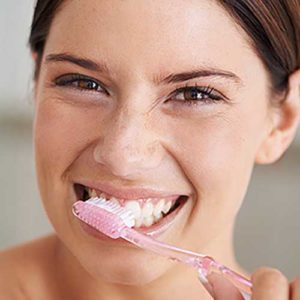Five Tips For Top-Notch Tooth Brushing

October is National Dental Hygiene Month—and it’s a great time to renew your commitment to good oral health. Everyone knows that to enjoy clean teeth and fresh breath, we need to brush and floss every day. But when it comes to the finer points of tooth brushing, there’s a lot of misunderstanding. So here are five tips to help you get the most bang from your brush.
Go Soft
A soft brush is much better for your mouth than a medium or hard one. That’s because stiffer bristles can actually damage soft gum tissue, and over-vigorous brushing can result in gum recession; this may lead to tooth sensitivity and an increased chance of decay. So always choose a soft-bristled toothbrush—and change your brush every three or four months, when its bristles begin to stiffen with use.
It Isn’t (Just) the Brush…
It’s the hand that holds it. Don’t brush too forcefully, or too long. If you consistently brush too hard, try using just three fingers to grip your brush so you apply less force. And if you have questions or need a refresher, just ask us to demonstrate proper brushing and flossing techniques next time you’re here.
Think Fluoride First
With many different flavors, whiteners, and other ingredients in toothpaste, which one should you choose? It’s up to you, as long as your toothpaste contains one vital ingredient—fluoride. This natural mineral has been proven to strengthen tooth enamel and fight cavities. Look for the seal of the American Dental Association (ADA) on the toothpaste tube: this certifies that it’s been tested for safety and effectiveness.
2×2 = Terrific Teeth
According to the ADA, brushing gently for two full minutes, two times a day, is the best way to get rid of plaque and prevent cavities. That’s why it should be an essential part of your oral hygiene routine. And while you’re at it, don’t forget to use dental floss (or another method) to clean the spaces in between your teeth. If you don’t remove plaque from these areas, your cleaning isn’t complete.
Preserve Your Enamel
There are some times when you should avoid brushing—like after you’ve consumed soda, or been sick to your stomach. That’s because the acids in soda and stomach juices actually soften tooth enamel, and brushing can quickly wear it away. In these situations, rinse your mouth out with water and wait at least an hour before you brush.
Practicing good oral hygiene is the best thing you can do for your teeth at home. But don’t forget to come to the office for regular checkups and professional cleanings! Because no matter how thorough you are, you can’t clean hardened deposits (calculus, or tartar) from your teeth at home: It takes special tools and the skilled hand of your hygienist or dentist to do that.
If you would like more information about tooth brushing and oral hygiene, please contact us or schedule an appointment for a consultation. You can learn more by reading the Dear Doctor magazine articles “Sizing Up Toothbrushes” and “10 Tips for Daily Oral Care at Home.”
